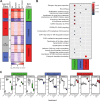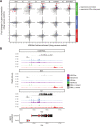Epigenetic and transcriptome responsiveness to ER modulation by tissue selective estrogen complexes in breast epithelial and breast cancer cells
- PMID: 35862394
- PMCID: PMC9302754
- DOI: 10.1371/journal.pone.0271725
Epigenetic and transcriptome responsiveness to ER modulation by tissue selective estrogen complexes in breast epithelial and breast cancer cells
Abstract
Selective estrogen receptor modulators (SERMs), including the SERM/SERD bazedoxifene (BZA), are used to treat postmenopausal osteoporosis and may reduce breast cancer (BCa) risk. One of the most persistent unresolved questions regarding menopausal hormone therapy is compromised control of proliferation and phenotype because of short- or long-term administration of mixed-function estrogen receptor (ER) ligands. To gain insight into epigenetic effectors of the transcriptomes of hormone and BZA-treated BCa cells, we evaluated a panel of histone modifications. The impact of short-term hormone treatment and BZA on gene expression and genome-wide epigenetic profiles was examined in ERαneg mammary epithelial cells (MCF10A) and ERα+ luminal breast cancer cells (MCF7). We tested individual components and combinations of 17β-estradiol (E2), estrogen compounds (EC10) and BZA. RNA-seq for gene expression and ChIP-seq for active (H3K4me3, H3K4ac, H3K27ac) and repressive (H3K27me3) histone modifications were performed. Our results show that the combination of BZA with E2 or EC10 reduces estrogen-mediated patterns of histone modifications and gene expression in MCF-7ERα+ cells. In contrast, BZA has minimal effects on these parameters in MCF10A mammary epithelial cells. BZA-induced changes in histone modifications in MCF7 cells are characterized by altered H3K4ac patterns, with changes at distal enhancers of ERα-target genes and at promoters of non-ERα bound proliferation-related genes. Notably, the ERα target gene GREB1 is the most sensitive to BZA treatment. Our findings provide direct mechanistic-based evidence that BZA induces epigenetic changes in E2 and EC10 mediated control of ERα regulatory programs to target distinctive proliferation gene pathways that restrain the potential for breast cancer development.
Conflict of interest statement
The authors have declared that no competing interests exist.
Figures





References
-
- Rossouw JE, Anderson GL, Prentice RL, LaCroix AZ, Kooperberg C, Stefanick ML, et al.. Risks and benefits of estrogen plus progestin in healthy postmenopausal women: principal results From the Women’s Health Initiative randomized controlled trial. JAMA. 2002;288(3):321–33. doi: 10.1001/jama.288.3.321 - DOI - PubMed
Publication types
MeSH terms
Substances
Grants and funding
LinkOut - more resources
Full Text Sources
Medical

